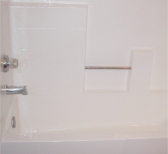
No matter what it's called by, it is what we do best.
Reglazing, refinishing, and resurfacing are terms that are now used to mean the same thing. By applying substances to the surface of an already installed fixture, a new surface can be obtained that is an improvement over the original one, which may be dull, discolored, or worn out from age and use.
Another aspect you want to consider is we can fix chips, cracks, rust, or even damage, alongside many other imperfections before applying the reglaze. All the work is done on-site, of course.
By reglazing, you can avoid replacement of the fixture, its functional life can be extended considerably, AND it’s easy to clean.

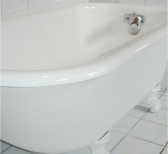
Porcelain feels hard and cold to the touch, and when you knock, it sounds like a heavy, thick metal under an often white finish.
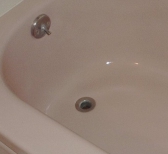
This fixture material feels cold to the touch. The sound when knocking on it indicates a somewhat thin, hard, hollow metal. This material’s name comes from the structural black metallic material that is used to create the form of the fixture. The fixture is made by putting a heated sheet of steel in a mold under heavy pressure. Then, it is coated with a porcelain-like, oven-baked finish. It is the same material seen in gas stoves. One unique characteristic of this material is that heavy impacts produce chipping of the finish on rounded areas, leaving black dents.
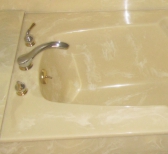
Cultured marble is a synthetic, heavy, plastic, resinous material that looks like natural stone. But upon touching it, you notice its temperature is not as cold or as warm as a natural stone would be under similar circumstances. Cultured marble tends to stay slightly warmer than the air in the room. If you knock on it, the sound it gives is duller than natural stone, almost like wood.
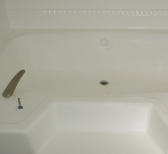
This plastic resin material is more difficult to identify since its surface feels and looks like most finishes applied to fiberglass fixtures. With acrylic, you can build thinner fixtures than with fiberglass, BUT they are usually thicker! To identify it with certainty, it is necessary to break, cut, or burn part of it. For our reglazing purposes, we treat acrylic finishes as if they are fiberglass.
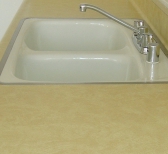
High Pressure Laminate is colloquially known as Formica®; the material is a thin sheet of hard, heat-resistant plastic resin that is laminated in layers and glued onto kraft paper, and finally onto wood as a veneer. Formica® is usually used on surfaces that require repetitive cleaning with damp cloths and/or liquid, like countertops, vanities, tables, etc.
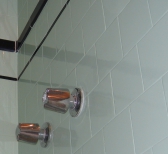
This ceramic product is the result of high-temperature oven melting of special clays. The oven is also used to melt the porcelain-like surface finish, which gives the tile its final color and texture.